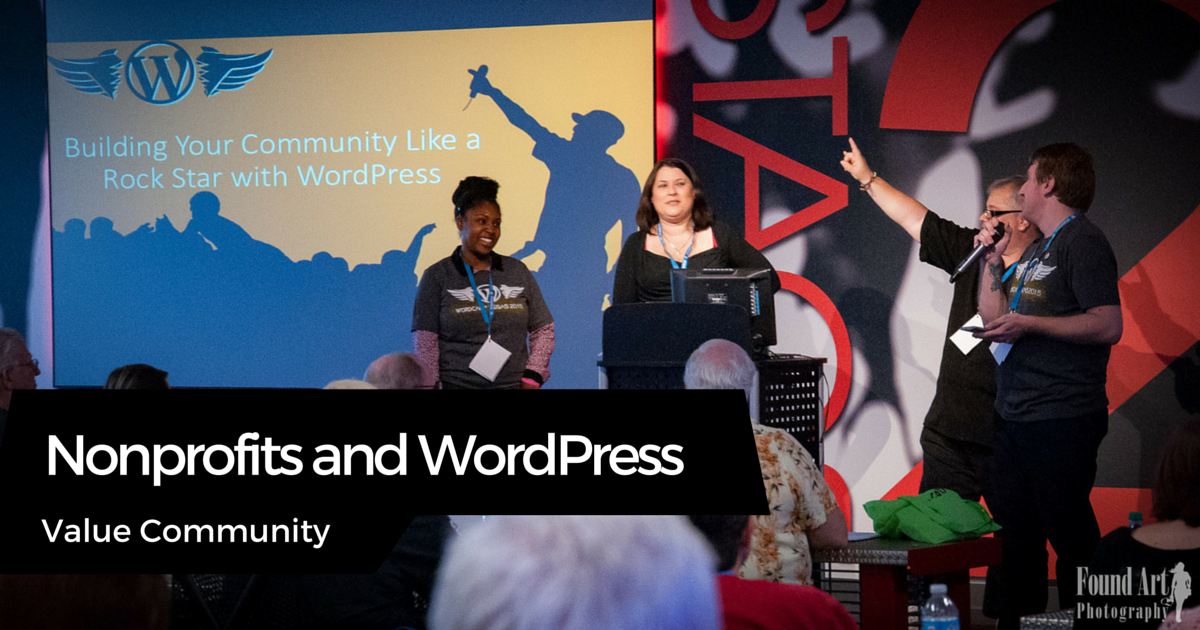Every nonprofit needs a great website to tell their story, recruit new donors, and easily accept donations online. WordPress does all of that — well.
The WordPress.org Website Content Managment System is a natural fit for nonprofits because of one key core value that each share — believing in and fostering community.
In each local, regional, and global arena both communities come together under a central mission. To learn about the mission of WordPress.org go here.
Living within a community allows us to participate in something greater than ourselves by giving our time, resources, and energy. The result? We strengthen both the individual and greater whole.
Before diving into community, let’s talk about company culture.
Company Culture and Nonprofits
Many company cultures emphasize service work and include doing good in the world as part of their core values. Greg Besner from CultureIQ in his Entrepreneur article “Why Company Culture Is More Important Than Ever” says,
“Prospective and current employees care about your reputation as a company. This reputation encompasses your employer brand and also your company’s social responsibility efforts, such as corporate giving, volunteerism and sustainability. What your company does and says needs to align with what employees believe.”
Buffer is one of the more famous, rapidly-growing tech companies who has a well-defined company culture. Since their staff works remotely, it’s even more important that the core values are intentional and clear.
In their article, “The 10 Buffer Values and How We Act on Them Every Day,” Joel Gascoinge, Co-Founder and CEO, describes how the book, “How To Win Friends and Influence People” by Dale Carnegie made a big impact on their culture.
“When I introduced my co-founder Leo to the book in the earliest few months of Buffer, he, too, was hooked and we had endless conversations and discussions around the stories and principles. He helped me grow as a person much more than I could alone, due to his excitement and interest of the How to Win Friends way. The result of this has been that we have based a large number of the values within the Buffer culture directly on the principles Carnegie proposes.”
Tony Hsieh, CEO of Zappos, is also known for the company culture created at Zappos, a shoe distribution company (well, more than that now) located in Las Vegas, Nevada. His book, “Delivering Happiness: A Path to Profits, Passion, and Purpose,” sparked a separate consultation company with the same name.
Hsieh takes the opposite approach to the workforce as Buffer — all employees work together. To Zappos, that’s important. He believes people should be able to come to work and be themselves. In “The Happiness Culture: Zappos Isn’t a Company — It’s a Mission” by Fast Company Tony says,
“There’s a lot of talk about work life separation or balance and so on, our whole thing is about work life integration. It’s just life. And so the ideal would be if you can be the same person at home as you are in the office, and vice versa. And when people actually feel comfortable being themselves, so much creativity comes out of that.”
These are only a few of the leading companies that share how company culture drives business purpose.
WordPress folks are no different. For most in WordPress, authenticity is as important as return on investment. And for most WordPress firms, even purpose and mission trump take-home salary.
If your company culture is an important part of your nonprofit organization, then shouldn’t your third party vendors also fit in? WordPress does!
Showing up for the mission matters. WordPress participates, just like your nonprofit.
WordPress values a stable, yet simple platform that allows anyone to use it fitting right in with the purpose of “democratizing publishing.”
WordPress is perfect for anyone from a beginner blogger who’s developing gardening tutorials to educate at-risk youth on sustainability to advance enterprises like Disney who uses WordPress to tell their story of magic and dreams. They each use WordPress.org and the best part is that WordPress.org core Software is free — and always will be.
Their philosophy documentation says:
“We’re never done with simplicity. We want to make WordPress easier to use with every single release. We’ve got a good track record of this, if you don’t believe us then just take a look back at some older versions of WordPress!”
It’s not just a pie-in-the-sky idea. Giving back is part of the WordPress Way. In “Five for the Future,” Matt Mullenweg challenged WordPress agencies to give 5% of their resources back to development of core.
“I think a good rule of thumb that will scale with the community as it continues to grow is that organizations that want to grow the WordPress pie (and not just their piece of it) should dedicate 5% of their people to working on something to do with core — be it development, documentation, security, support forums, theme reviews, training, testing, translation or whatever it might be that helps move WordPress mission forward.”
And this kind of contribution doesn’t include the people who volunteer to organize the 80+ WordCamps, the speakers or the volunteers.
The core of a nonprofit is giving. This is the same for WordPress.

WordPress is a generous community. Bigger than WordPress.org is the Open Source community which attracts a group of like-minded folks who believe iterations for the better are a good thing over propriety for the few.
Look no further than where WordPressers gather — at Wordcamps! At WordCamps, WordPress-focused conferences that emphasize learning, developing, and making friends, the support area is called the “happiness bar.” People volunteer their time at the Happiness Bar to help you with any WordPress question or site issue.
Since WordPress is a growing platform, people are adopting the platform more and more. The culture of WordPress encourages beginners to feel safe for any question they ask. Curiosity is encouraged. The community is not only familiar with beginners who are just starting, they embrace beginners. Unlike many developers or content management system communities who may look down on those entering the space, WordPress is inclusive and helps them rise up.
Simply visit a WordCamp and you’ll see many more t-shirts and converse with smiling faces than jackets and slacks with a discerning eye. It’s a community for the community; and not one for a few small individuals.
And like your nonprofit, we’re also inspired by the best, too. We love smiling and helping others, when they just don’t get the web.
“The easiest way to ensure that your employees smile when they greet a customer, is to only hire employees who smile all the time.” – Howard Schultz
In his video to a real estate focused group, Jeff Turner, friend and part of the WordPress Community, talks about how community isn’t the main thing, it’s the only thing.
“Nothing real; nothing true happens without the community. …You have to make sacrifices to protect community.” Jeff Turner
Nonprofits Strengthen Their Communities. So does WordPress.
When folks participate and give, the community grows — naturally. And for both WordPressers and those generating new donations online, the community is interest-based, in a specific geography, raising awareness for the movement. We’re much more alike than you first thought, huh?
The Bill and Melinda Gates Foundation believes in doing good work right in their own state. They say,
“Strong communities need the capacity to create opportunity and to solve their own problems. We work to strengthen local philanthropic institutions, such as community foundations and United Way organizations, because these partners know their local communities best.”
Give user, Will Chambers of ShuGuy Ministries, does the same. Will wanted to do something simple: give new or gently-used shoes to the homeless in his area: Vancouver Island. And that’s how he builds his community up.
Nonprofits also build their communities with social media and private forums on their sites. This is an especially-effective method for issue-related causes, where geography may hinder meetups and local events.
“Five Nonprofit Online Communities that Inspire Action & Generate Results” by Michael Wilson on NTEN’s site highlights some case studies from nonprofits like Relay for Life, American Heart Association, and Operation Smile.
WordPress strengthens communication. Nonprofits benefit.
Each nonprofit can tailor their communication with their own community in a way that encourages and empowers them to become an ambassador. The effect of a strong community is the cause becomes more effective for change.
And since it’s 2016 and the web really matters. No, REALLY MATTERS; it may make sense to talk to a WordPress website agency prior to selecting that slick new proprietary web and donation platform system. Propriety is dead. Stop over-paying for technology.
Regardless of what the sales guy says, WordPress is powerful and a perfect choice for accepting donations online for your NonProfit.


